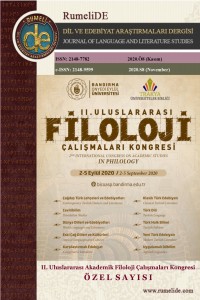Abstract
Ömer Necmî Efendi (1815-1889) asker olması nedeniyle Anadolu’nun çeşitli yerlerinde bulunmuş, Kula Redif binbaşılığından emekli olup Manisa Alaşehir’e yerleşmiştir. Halvetî, Şâzelî ve Rufâî tarikatlarına mensup olan şair, manevi yolculuğuna hayatı boyunca devam etmiş, emekli olduktan sonra da uzun müddet Alaşehir’de bir dergâhta görev yapmıştır. Ömrünün son zamanlarını İstanbul’da geçirmiştir. Şairin Türkçe Dîvân, Kasîde-i Elfiyye, Tuhfe-i Vahdet ve Farsça Dîvânçe olmak üzere dört eseri olduğu bilinmektedir. Bazı kaynaklarda ise Necmî’nin Farsça bir dîvânçesi olduğundan bahsedilmemiş, şairin sadece Farsçaya olan hâkimiyeti övülmüştür. Bunda Dîvânçe’nin Türkçe Dîvân ile birlikte basılmış olmasının etkili olduğu düşünülebilir. Ancak iki eserin de birbirinden müstakil başlıklarla ayrıldığı göz ardı edilmemelidir. Çoğunluğu tasavvufî gazellerden oluşan ve 3 farklı tarihte (H. 1280, H. 1284 ve H. 1287) basılmış olduğu görülen eser üzerinde şimdiye kadar herhangi bir çalışma yapılmadığı fark edilmiştir. Halbuki Necmî’nin hayatı hakkında kaynaklarda verilen bilgilerin sınırlı olduğu ve pek çok malumata şairin kendi eserlerinden hareketle ulaşıldığı düşünüldüğünde bu eserinin de gün yüzüne çıkması gerekmektedir. Bu doğrultuda, çalışmamızda Ömer Necmî Efendi’nin Farsça Dîvânçe’si biçim ve içerik yönüyle tanıtılıp değerlendirilmiştir. Ayrıca, şairin Dîvânçe’deki şiirlerini kaleme alırken en fazla tercih ettiği iki aruz kalıbının Türkçe Dîvân’ıyla benzerlik göstermesi ve Farsça şiirlerinde sıklıkla askerî terimler ile musikiye dair unsurlara yer vermesi eserin dikkat çekici yönleri olarak ön plana çıkmıştır.
Keywords
References
- Adar, Ç. (2012). Halvetilikte müziğe karşı inanç ve tutumların incelenmesi (Yayımlanmamış Sanatta Yeterlilik Tezi). Afyon Kocatepe Üniversitesi, Afyon.
- Arslan, M. (2014). Türk edebiyatı isimler sözlüğü. Erisim adresi: http://teis.yesevi.edu.tr/madde-detay/necmi-omer-necmi-efendi-istanbullu
- Aydın, Ş. (2004). Türk edebiyatında Farsça divân ve divânçeler. NÜSHA Şarkiyat Araştırmaları Dergisi, IV (15), 31-40.
- Bursalı Mehmed Tâhir (1333). Osmanlı mü’ellifleri II. İstanbul: Matbaa-i ‘Âmire.
- Dilçin, C. (2013). Örneklerle Türk şiir bilgisi. Ankara: Türk Dil Kurumu Yayınları.
- İpekten, H. (2007). Eski Türk edebiyatı nazım şekilleri ve aruz. İstanbul: Dergâh Yayınları.
- Karga Göllü, B. (2019). Meydan okuyan bir kadın şair: Âdile Sultan Divanı’nda vatan ve savaşla ilgili benzetmeler. Journal Of Institute Of Economic Development and Social Researches, 5 (18), 195-205.
- Kurnaz, C. ve Tatcı M. (2001). Tuhfe-i Nâ’ilî divân şâirlerinin muhtasar biyografileri ıı. Ankara: Bizim Büro Yayınları.
- Mengi, M. (2010). Divan şiiri yazıları. Ankara: Akçağ.
- Özel, A. M. (2010). Şâzeliyye. DİA (C. 38, 387-390), İstanbul: TDV.
- Paşazade, E. (2002). Necmî Ömer Efendi’nin Dîvan, Tuhfe-i Vahdet ve Kasîde-i Elfiyye isimli eserlerinin transkripsiyonlu metni ve Dîvanı’nın incelemesi (Yayımlanmamış Yüksek Lisans Tezi). Cumhuriyet Üniversitesi, Sivas.
- Şentürk, A. A. ve Kartal, A. (2005). Üniversiteler için eski Türk edebiyatı tarihi. İstanbul: Dergâh Yay.
- Uludağ, S. (1992). İslam açısından mûsikî ve semâ. Bursa: Uludağ Yayınları.
- Uzunca, İ. H. (2019). Necmî Alî Dîvançesi (Yayımlanmamış Yüksek Lisans Tezi). Marmara Üniversitesi, İstanbul.
Abstract
Omer Necmi Efendi (1815-1889) had been in various parts of Anatolia due to his military service, he served as a major at Kula and when he retired from his position, he settled in Manisa Alaşehir. Being a member of Halveti, Şazeli and Rufai sects, the poet continued his spiritual journey throughout his life, and after retiring, he worked in a lodge in Alaşehir for a long time. He spent the last times of his life in Istanbul. It is known that the poet had four works in Turkish Diwan, Kaside-i Elfiyye, Tuhfe-i Vahdet and Persian Diwanche. In some sources, it is not mentioned that Necmi has a Persian diwanche, and only the poet's dominance in Persian is praised. It can be thought that the fact that the Diwanche was published together with the Turkish Diwan was effective in this. However, it should not be overlooked that both works are separated by separate titles. It has been noticed that no work has been carried out on the work, most of which is composed of Sufi gazelles and printed in 3 different dates (H. 1280, H. 1284 and H. 1287). However, considering that the information given in the sources about Necmi's life is limited and that many information can be obtained from the poet's own works, this work should come to light. In this direction, in our study, the Persian Diwanche of Omer Necmi Efendi was introduced and evaluated in terms of form and content. In addition, the fact that the poet's most preferred two prosody patterns while writing his poems in Diwanche are similar to the Turkish Diwan and that they frequently include military terms and elements related to music in Persian poems stand out as the remarkable aspects of the work.
Keywords
References
- Adar, Ç. (2012). Halvetilikte müziğe karşı inanç ve tutumların incelenmesi (Yayımlanmamış Sanatta Yeterlilik Tezi). Afyon Kocatepe Üniversitesi, Afyon.
- Arslan, M. (2014). Türk edebiyatı isimler sözlüğü. Erisim adresi: http://teis.yesevi.edu.tr/madde-detay/necmi-omer-necmi-efendi-istanbullu
- Aydın, Ş. (2004). Türk edebiyatında Farsça divân ve divânçeler. NÜSHA Şarkiyat Araştırmaları Dergisi, IV (15), 31-40.
- Bursalı Mehmed Tâhir (1333). Osmanlı mü’ellifleri II. İstanbul: Matbaa-i ‘Âmire.
- Dilçin, C. (2013). Örneklerle Türk şiir bilgisi. Ankara: Türk Dil Kurumu Yayınları.
- İpekten, H. (2007). Eski Türk edebiyatı nazım şekilleri ve aruz. İstanbul: Dergâh Yayınları.
- Karga Göllü, B. (2019). Meydan okuyan bir kadın şair: Âdile Sultan Divanı’nda vatan ve savaşla ilgili benzetmeler. Journal Of Institute Of Economic Development and Social Researches, 5 (18), 195-205.
- Kurnaz, C. ve Tatcı M. (2001). Tuhfe-i Nâ’ilî divân şâirlerinin muhtasar biyografileri ıı. Ankara: Bizim Büro Yayınları.
- Mengi, M. (2010). Divan şiiri yazıları. Ankara: Akçağ.
- Özel, A. M. (2010). Şâzeliyye. DİA (C. 38, 387-390), İstanbul: TDV.
- Paşazade, E. (2002). Necmî Ömer Efendi’nin Dîvan, Tuhfe-i Vahdet ve Kasîde-i Elfiyye isimli eserlerinin transkripsiyonlu metni ve Dîvanı’nın incelemesi (Yayımlanmamış Yüksek Lisans Tezi). Cumhuriyet Üniversitesi, Sivas.
- Şentürk, A. A. ve Kartal, A. (2005). Üniversiteler için eski Türk edebiyatı tarihi. İstanbul: Dergâh Yay.
- Uludağ, S. (1992). İslam açısından mûsikî ve semâ. Bursa: Uludağ Yayınları.
- Uzunca, İ. H. (2019). Necmî Alî Dîvançesi (Yayımlanmamış Yüksek Lisans Tezi). Marmara Üniversitesi, İstanbul.
Details
| Primary Language | Turkish |
|---|---|
| Subjects | Linguistics |
| Journal Section | Turkish language, culture and literature |
| Authors | |
| Publication Date | November 21, 2020 |
| Published in Issue | Year 2020 Issue: Ö8 |


